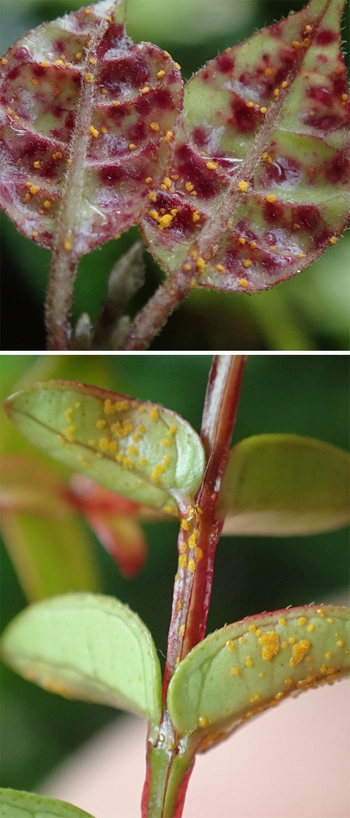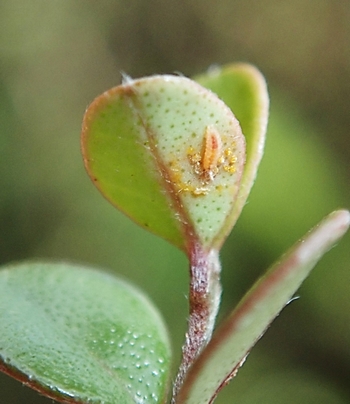PESTS AND DISEASES OF FORESTRY IN NEW ZEALAND
Overview of myrtle rust since its arrival
Scion is the leading provider of forest-related knowledge in New Zealand
Formerly known as the Forest Research Institute, Scion has been a leader in research relating to forest health for over 50 years. The Rotorua-based Crown Research Institute continues to provide science that will protect all forests from damage caused by insect pests, pathogens and weeds. The information presented below arises from these research activities.
From Forest health News 308, May 2022
An unwelcome “guest”
May 2022 marks the 5th anniversary of the arrival of Austropuccinia psidii (myrtle rust) to the New Zealand mainland. Myrtle rust is a significant disease of plants in the myrtle family (Myrtaceae) that originates from South America. Following detection in New Zealand, the Ministry for Primary Industries (MPI) immediately initiated a rigorous incursion response, but the pathogen continued to spread and is now widely established. The disease threatens myrtles of economic, environmental and socio-cultural importance. Here we reflect on the research Scion has contributed to better understand and manage this disease.

Active myrtle rust infection on Lophomyrtus bullata and Metrosideros diffusa.
Research Accord
The New Zealand Government has funded research through the Ministry for Primary Industries (MPI), the Department of Conservation (DOC), Regional Councils and several Ministry of Business, Innovation and Employment (MBIE) research programmes, including Beyond Myrtle Rust: Towards Ecosystem Resilience, Nga Rakau Taketake (NRT), the Catalyst Fund and the Strategic Science Investment Fund (SIFF). Research has been highly collaborative, involving mana whenua, Crown Research Institutes, such as Scion, Plant & Food Research (PFR) and Manaaki Whenua Landcare Research (MWLR), as well as several universities and international collaborators.
Host susceptibility
Understanding whether resistance to disease is present in host populations is key when developing management and conservation strategies. Scion, in collaboration with PFR, the Queensland Department of Agriculture and Fisheries (QDAF), and others, assessed the susceptibility of pohutukawa (Metrosideros excelsa), manuka (Leptospermum scoparium), ramarama (Lophomyrtus bullata), rohutu (Lophomyrtus obcordata), kanuka (Kunzea robusta), and rawiri manuka (Kunzea linearis) seedlings under controlled conditions. Ramarama, rohutu, and pohutukawa were all highly susceptible. Susceptibility varied considerably among provenances for the other species.1 These findings identified species most at threat, provided insight into resistance mechanisms and informed further research.
Field trails were an important next step in host susceptibility testing to determine vulnerability under natural conditions. Scion in collaboration with PFR studied disease development in field trials in Rotorua and Auckland. Ramarama, rohutu, and pohutukawa are all highly susceptible under field conditions at both locations, whereas kanuka and manuka are more resistant, with only a low incidence of disease observed on manuka fruit. Disease severity is greater in Auckland, with active infection present through winter, in comparison to the colder Rotorua site.
Surveillance and monitoring of the disease
Surveillance and monitoring in native forest has further demonstrated the threat to susceptible hosts. Tracking the disease through time in natural populations has strengthened our understanding of the seasonal nature of myrtle rust epidemics and their close association with periods of host growth and reproduction. Scion researchers have monitored disease impacts and changes in tree health in the Bay of Plenty, Auckland and Taranaki. At sites where the pathogen is well established, the disease has had a significant impact on growth and reproduction of Lophomyrtus.2 At sites that were initially free from disease, a gradual increase in disease has been observed.
Symptoms have also been recorded on myrtles co-occurring with the highly susceptible Lophomyrtus species, such as climbing rata (Metrosideros diffusa, M. fulgens and M. perforata). The current impact on climbing rata is usually relatively low; however, severe disease has been reported from plants in close proximity to heavily infected hosts. Auckland University Masters’ student Ngaio Balfour, based at Scion, is investigating the link between disease severity on rata and maire tawake in proximity to symptomatic Lophomyrtus trees.
Continued monitoring of the disease across the entire country will require additional tools. Scion has worked on the development of deep learning models that use aerial imaging to identify and map host species.3 These tools will support forest health monitoring and future biosecurity responses.
Disease control strategies
Chemical and biological control options are needed to help manage myrtle rust in the near and long-term. Scion has trialled different chemical options, including the addition of different adjuvants to improve fungicide delivery across leaf surfaces. Vandia®, Flint®, and Sercadis® have shown promise as chemical treatments, while adjuvants such as Actiwett® and Radial® have significantly improved the distribution of these fungicides over leaf surfaces.4 While fungicides can be an important management tool in certain situations, their use to protect trees in natural settings will often not be practical.
To better inform further research efforts in this area, Scion, in partnership with New Zealand Plant Producers Incorporated (NZPPI), will soon survey nurseries to identify which myrtle species are stocked, what impact myrtle rust has had, and which control tools and methods are currently used. This research will identify the needs of nurseries and identify knowledge gaps for future research.
Natural enemies
Natural enemies may play an important role in reducing inoculum pressure in the environment. During fieldwork, small fly larvae (Cecidomyiidae) are often observed feeding on myrtle rust. This fly is being formally described as a new species. Scion, working with MWLR, have started to investigate the potential host range and distribution of Mycodiplosis in New Zealand by inspecting rust specimens curated in herbaria.

Mycodiplosis spp. larvae on L. obcordata leaf with myrtle rust symptoms from Awhitu Peninsula.
Pathogen adaptability and life cycle
Understanding the life cycle of the pathogen is important for long-term management. Researchers at Scion are working to fill gaps in our knowledge about the life cycle of A. psidii with collaborators at the University of Queensland and QDAF. An assessment of the genetic diversity of New Zealand populations of A. psidii is underway. The sexual stage has been observed in all established populations and is more abundant between January to March. Where sexual reproduction occurs, even in small amounts, populations are expected to have greater genotypic diversity that may make them more adaptable. Scion is undertaking controlled trials to investigate potential environmental and host drivers of sexual reproduction. This is important to understand what could happen if a new strain of A. psidii were to arrive in New Zealand.
Threat of other strains
Multiple strains of A. psidii have been identified, but only the “pandemic strain” is currently present in New Zealand. To examine the threat of strains currently outside of New Zealand, Scion has partnered with international collaborators including the Forestry and Agricultural Biotechnology Institute (FABI) in South Africa and the Facultdad de Agronomica in Uruguay. Pohutukawa, manuka, kanuka, and rawiri manuka, were sent to collaborators to be tested under controlled conditions. All species were found to be susceptible, with manuka and pohutukawa the most susceptible, and kanuka the least susceptible to the South African5 and Eucalyptus (Uruguay)6 strains. These findings highlight the need for continued biosecurity measures to keep additional strains of the pathogen out of New Zealand. To support this, Scion is working with PFR and Colorado State University to develop a new diagnostic test capable of distinguishing between different strains.
Social science understanding impacts and values
Scion’s social researchers are working within NRT on human impact, engagement and values underlying our responses to myrtle rust. Understanding impacts from a whole system perspective across social and cultural values, as part of economic and environmental consequences, is part of the work being co-led by Scion with the University of Auckland. Together, we are supporting researchers in thinking more holistically about our responses to plant pathogens; building capacity to better assess and address cross-cutting issues of plant pathogens on people and the environment. Other project work is focussing on the conceptual shifts needed to accommodate working across different knowledge systems, with a focus on colonial biases in the way we understand plant pathogens and how we resource our responses to them. Resources are being developed to help engage with people impacted, including different strategies for raising awareness and interventions for monitoring and mitigating impacts.
Where are we now?
It is clear that the New Zealand climate is favourable to A. psidii, with the pathogen well established on susceptible myrtle species in native forests, nurseries and urban settings across the country. Some myrtle species are more susceptible than others, and the task now is to find ways of effectively managing the disease to ensure the survival of these species. Part of that requires that we continue to engage communities, particularly Maori, as species and environments impacted are taonga.
Scion has already begun doing that. We are leading a Jobs for Nature-funded project, Myrtle Rust Jobs for Resistance programme Te Rara Whakamaru being delivered in partnership with the Rotoiti 15 Trust. Working with mana whenua in the Bay of Plenty region, a team of eight trained kaimahi are surveying and monitoring the spread of myrtle rust, reporting on tree health, and identifying potential disease resistance. The project is developing knowledge of myrtle rust impact in native forest and contributing to a culturally appropriate conservation strategy to protect our most at-risk species.
What can you do?
Further resources can be found at
https://www.myrtlerust.org.nz
If you observe myrtle rust, please report it at
https://www.inaturalist.org/projects/myrtlerust-reporter
Key Contact: Dr Stuart Fraser
stuart.fraser@scionresearch.com
1 Smith, G. R., Ganley, B. J., Chagné, D., Nadarajan, J., Pathirana, R. N., Ryan, J., Arnst, E. A., Sutherland, R., Soewarto, J., Houliston, G., Marsh, A. T., Koot, E., Carnegie, A. J., Menzies, T., Lee, D. J., Shuey, L. S., & Pegg, G. S. (2020). Resistance of New Zealand provenance Leptospermum scoparium, Kunzea robusta, Kunzea linearis, and Metrosideros excelsa to Austropuccinia psidii. Plant Disease, 104(6), 1771-1780.
2 Sutherland, R., Soewarto, J., Beresford, R., & Ganley, B. (2020). Monitoring Austropuccinia psidii (myrtle rust) on New Zealand Myrtaceae in native forest. New Zealand Journal of Ecology, 44(2), 3414.
3 Pearse, G.D., Watt, M.S., Soewarto, J., & Tan, A.Y.S. (2021) Deep Learning and Phenology Enhance Large-Scale Tree Species Classification in Aerial Imagery during a Biosecurity Response. Remote Sensing. 13, 1789.
4 Adusei-Fosu, K., Rolando, C. A., Richardson, B., van Leeuwen, R., Gaskin, R., Bader, M. K.-F., & Pathan, A. K. (2021). Evaluating the efficacy of potential fungicide-adjuvant combinations for control of myrtle rust in New Zealand. Journal of Plant Diseases and Protection, 128, 1501-1515.
5 Soewarto, J., Somchit, C., du Plessis, E., Barnes, I., Granados, G. M., Wingfield, M. J., Shuey, L., Bartlett, M., Fraser, S., Scott, P., Miller, E., Waipara, N., Sutherland, R., & Ganley, B. (2021). Susceptibility of native New Zealand Myrtaceae to the South African strain of Austropuccinia psidii: A biosecurity threat. Plant Pathology, 70(3), 667-675.
6 Unpublished data
This information is intended for general interest only. It is not intended to be a substitute for specific specialist advice on any matter and should not be relied on for that purpose. Scion will not be liable for any direct, indirect, incidental, special, consequential or exemplary damages, loss of profits, or any other intangible losses that result from using the information provided on this site.
(Scion is the trading name of the New Zealand Forest Research Institute Limited.)

 Farm Forestry New Zealand
Farm Forestry New Zealand

